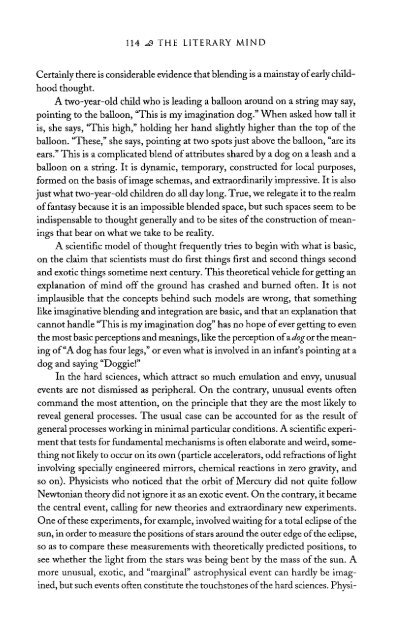The Literary Mind.pdf
The Literary Mind.pdf
The Literary Mind.pdf
You also want an ePaper? Increase the reach of your titles
YUMPU automatically turns print PDFs into web optimized ePapers that Google loves.
114 THE LITERARY MIND<br />
Certainly there is considerable evidence that blending is a mainstay of early childhood<br />
thought.<br />
A two-year-old child who is leading a balloon around on a string may say,<br />
pointing to the balloon, "This is my imagination dog." When asked how tall it<br />
is, she says, "This high," holding her hand slightly higher than the top of the<br />
balloon. "<strong>The</strong>se," she says, pointing at two spots just above the balloon, "are its<br />
ears." This is a complicated blend of attributes shared by a dog on a leash and a<br />
balloon on a string. It is dynamic, temporary, constructed for local purposes,<br />
formed on the basis of image schemas, and extraordinarily impressive. It is also<br />
just what two-year-old children do all day long. True, we relegate it to the realm<br />
of fantasy because it is an impossible blended space, but such spaces seem to be<br />
indispensable to thought generally and to be sites of the construction of meanings<br />
that bear on what we take to be reality.<br />
A scientific model of thought frequently tries to begin with what is basic,<br />
on the claim that scientists must do first things first and second things second<br />
and exotic things sometime next century. This theoretical vehicle for getting an<br />
explanation of mind off the ground has crashed and burned often. It is not<br />
implausible that the concepts behind such models are wrong, that something<br />
like imaginative blending and integration are basic, and that an explanation that<br />
cannot handle "This is my imagination dog" has no hope of ever getting to even<br />
the most basic perceptions and meanings, like the perception of a dog or the meaning<br />
of "A dog has four legs," or even what is involved in an infant's pointing at a<br />
dog and saying "Doggie!"<br />
In the hard sciences, which attract so much emulation and envy, unusual<br />
events are not dismissed as peripheral. On the contrary, unusual events often<br />
command the most attention, on the principle that they are the most likely to<br />
reveal general processes. <strong>The</strong> usual case can be accounted for as the result of<br />
general processes working in minimal particular conditions. A scientific experiment<br />
that tests for fundamental mechanisms is often elaborate and weird, something<br />
not likely to occur on its own (particle accelerators, odd refractions of light<br />
involving specially engineered mirrors, chemical reactions in zero gravity, and<br />
so on). Physicists who noticed that the orbit of Mercury did not quite follow<br />
Newtonian theory did not ignore it as an exotic event. On the contrary, it became<br />
the central event, calling for new theories and extraordinary new experiments.<br />
One of these experiments, for example, involved waiting for a total eclipse of the<br />
sun, in order to measure the positions of stars around the outer edge of the eclipse,<br />
so as to compare these measurements with theoretically predicted positions, to<br />
see whether the light from the stars was being bent by the mass of the sun. A<br />
more unusual, exotic, and "marginal" astrophysical event can hardly be imagined,<br />
but such events often constitute the touchstones of the hard sciences. Physi-















